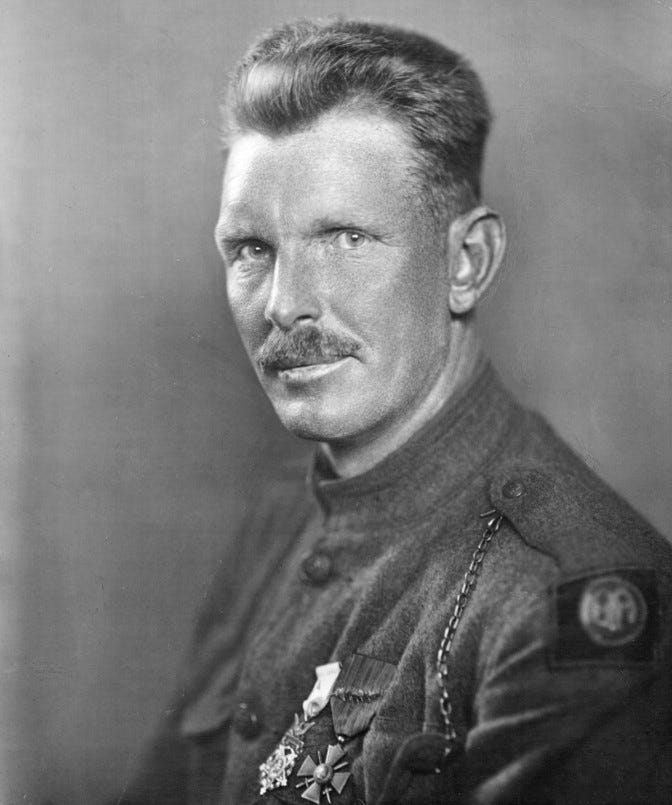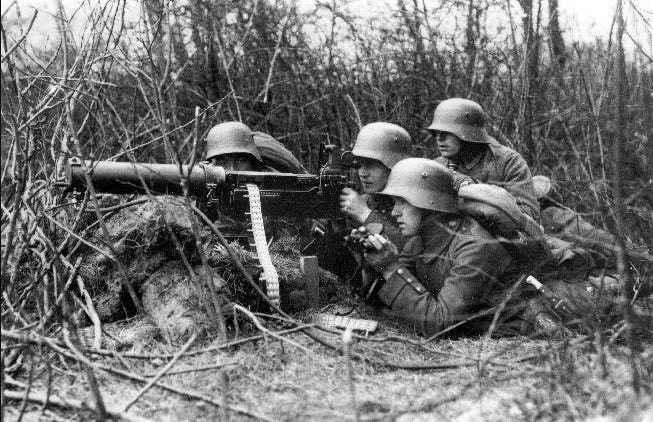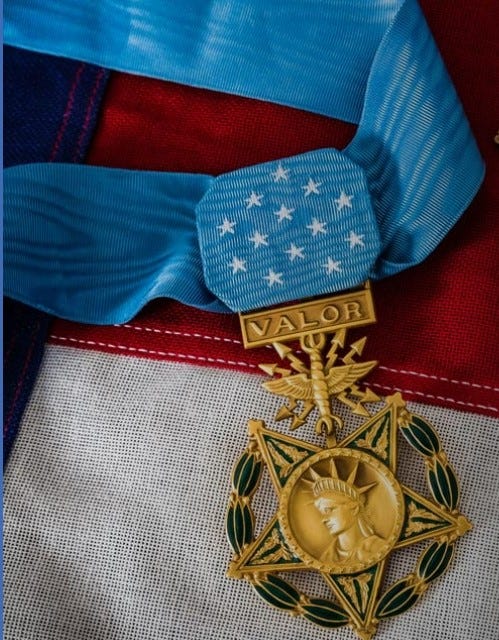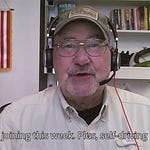Housekeeping
First, housekeeping notes. I turned on paid subscriptions last week — thanks to those of you who have upgraded your subscription so far — and then I went back and unbanned the comments for free subscribers. Whether you are paid or free, you may make comments and view my responses, and I welcome your interaction.
Your subscription upgrade helps keeps this business in business. (Have I mentioned how much time I put into this?) If you value the content and purpose of The Alligator Blog, then I invite you to share in making it happen.
Alvin York, Medal of Honor Recipient
I don’t recall the first time I saw “Sergeant York”, with Gary Cooper and Walter Brennan, but I YouTube-streamed it on a laptop last year during one of those interminable hospital nights, while waiting to see if I would walk out under my own power, or be carried out on a slab.
The nice thing about a 1941 war movie is there is no left-wing politics, no adult themes and absolutely zero foul language.
Born into poverty in rural Tennessee, Alvin York learned to shoot and hunt in the tradition of Daniel Boone. He worked as a low-skilled laborer and developed a reputation as a drinker and brawler.
And then he was awarded the Congressional Medal of Honor.
At age 27, through the emotional trauma of the death of a friend in a bar fight and through a revival service at the local Church of Christ, he converted from hillbilly hell-raiser to responsible Christian. The church imposed strict rules forbidding alcohol, dancing, swearing, gambling, and, of course, killing.
Apparently the conversion was a genuine experience, for Alvin York’s life changed dramatically. When he received his draft notice for World War I in 1917, conflict arose. Because of his church’s teachings, he filed for Conscientious Objector status, scrawling on the card, “Don’t want to fight.”
I suspect this was a classic case of taking the archaic King James language “Thou shalt not kill” literally, rather than seeing it in context as, “Thou shalt not murder.” (Exodus 20:13)
The draft board refused the CO designation, and continued to refuse on appeal.
Fortunately for York, his company commander at Camp Gordon, Georgia, was Ned Buxton (who 20 years later helped build the OSS), a thoughtful man who was impressed with York’s marksmanship as well as his sincerity. Buxton gave the recruit 10 days leave to go home and decide whether to fight.
In the movie version, Gary Cooper sits with his dog and his Bible on a mountain outcropping for a couple of days. A little unrealistic, but at least there is compellingly dramatic “Will the gentle giant step up to defend freedom?” music playing.
In a week, York reconciled himself to the conviction that sometimes war is necessary, and that those who can fight, should fight. He also knew he was superbly accurate with a rifle, could keep his head in a crisis, and could be a serious contributor to the U.S. expeditionary force.
The movie version has him convinced by a reading of Matthew 22:21 Render therefore unto Caesar the things which are Caesar's; and unto God the things that are God's.
Whether the wind actually rippled the pages of his Bible to miraculously reveal the passage to him, or not, at least it matched up nicely with American foreign policy on the eve of World War II.
Alvin York shipped out to France, M1917 bolt action Enfield rifle in hand. (There remains much debate over whether it was a 1917 Enfield or a 1903 Springfield. In the movie, Gary Cooper is shown with a knock-off 1903. I can’t solve that one.)
The U.S. entry into WWI was late in the war. Allied British and French troops were stalemated against the Kaiser’s forces in trench warfare on the continent. When U.S. General John “Black Jack” Pershing arrived at the head of the inexperienced and still-in-transit American Expeditionary Force (AEF), he met with Allied leaders. A plan was laid out for U.S. participation in an offensive in the Meuse-Argonne region of France.
Before commencing this battle, however, French General Ferdinand Foch, the Allied Commander-in-Chief, changed Pershing’s orders. Pershing studied the map and realized that with this last-minute change, American troops would be split up and fed into British and French lines piecemeal.
Black Jack’s troops would lose their identity as a fighting unit.
During a heated two-hour meeting, during which the robust and determined American considered punching the Frenchman in the nose, Pershing refused to have his troops broken into separate units. “While our army will fight wherever you may decide,” he stated flatly, “it will not fight except as an independent American army.”
A compromise was reached. Pershing could retain his unitary American command, but the price was a significantly more difficult assignment. His men would have to mount two offensives in a period of two weeks, against some of the stiffest resistance in the area.
The Americans went into the fire in the largest, and last, offensive operation of World War I.
October, 1918, Argonne Forest. York, now a Corporal in the U.S. Army 82nd Infantry Division, joined two sergeants and 14 other men in an effort to take the Decauville railway station. In the dark, and with a map labeled in French, the detachment became disoriented and ended up behind enemy lines.
A sudden firefight broke out. In the darkness and confusion, 17 surprised Germans surrendered to what they thought was a far superior force. Realizing their error, they called for help as they laid down their weapons.
A German machine gun nest — there were over 30 German machine guns positioned on the slope above — opened fire. Both of York’s sergeants went down. Half the tiny American force was killed outright, and now Corporal York was in charge.
Ordering the remaining men to stay down and watch over the prisoners, he worked his way through the darkness to get close to the machine gun nest, trading fire with them from time to time. He received support from his comrades who fired as they had opportunity.
And those machine guns were spitting fire and cutting down the undergrowth all around me something awful. And the Germans were yelling orders. You never heard such a racket in all of your life. I didn't have time to dodge behind a tree or dive into the brush… As soon as the machine guns opened fire on me, I began to exchange shots with them. There were over thirty of them in continuous action, and all I could do was touch the Germans off just as fast as I could. I was sharp shooting… All the time I kept yelling at them to come down. I didn't want to kill any more than I had to. But it was they or I. And I was giving them the best I had.
Close to the machine gun nest, York was low on ammunition for his rifle, when suddenly, 5 enemy troops (some accounts say 6) (other accounts say 7), charged his position, rifles spitting bullets.
The Enfield bolt-action rifle was a workhorse but follow-up shots were slow.
The Tennessee boy, a dead shot with rifle, laid the Enfield aside and pulled his 1911 Government Model pistol from its flapped holster. This was the venerable .45 semi-automatic with a 7-round magazine, tiny sights and a hammer that drew blood from the shooter’s thumb.
At close range, he put the attackers down with one round each, then returned to his rifle.
Approaching the machine gun nest, York accepted the surrender of the gun commander who decided not to lose any more men that night. The German surrendered his entire battalion to Alvin York, and then, to his dismay, discovered that York’s weakened detachment amounted to only 7 U.S. soldiers.
Other Germans, seeing the surrendering parade of their comrades, laid down their arms and joined the procession.
When the action was over, 25 German soldiers lay dead. Accounts vary of who did what to whom. It is likely York himself accounted for 18 or 19 of them, but he would never claim more than 9, and he was apparently regretful of those.
By the time the column made it to American lines under the watchful eyes of York and his few men, the disarmed enemy amounted to 132 prisoners.
For his actions that night, York was awarded the Congressional Medal of Honor:
After his platoon had suffered heavy casualties and three other noncommissioned officers had become casualties, Cpl. York assumed command. Fearlessly leading seven men, he charged with great daring a machine-gun nest which was pouring deadly and incessant fire upon his platoon. In his heroic feat the machine-gun nest was taken, together with four officers and 128 men and several guns.
Welcomed home with a ticker tape parade in New York City, lucrative endorsement solicitations poured in. York refused them all and went back to his farm in Tennessee.
Alvin York, interestingly, remained a pacifist. He publicly refused to support American involvement in what he saw as a second European war, until he began to understand Adolf Hitler. Through contacts in the movie industry, he came to accept the reality of the Nazi menace. By 1941, when the movie was released, he was offering full-throated support to U.S. intervention.
He tried to re-enlist, but was disqualified for age.
In 1954 Alvin York suffered a stroke that left him bedridden until his death a decade later.
Theological Contemplations
It was too bad York was only semi-literate. He had a total of only 9 months of formal education. It was enough to allow him to read the history book Ned Buxton gave him, which helped the young man’s understanding of warfare, and it was adequate for him to keep a dairy of his European war, but those exercises no doubt stretched him.
How much better if he had had access to the writings of the church fathers on Just War Theory.
Saint Augustine of Hippo (AD 354-430) is generally credited with the first orthodox, Biblical justification for warfare.
But it was Saint Thomas Aquinas (AD 1224-1274) who gave Just War Theory its depth by identifying appropriate conditions for a righteous war, and, importantly, limiting its scope. Below is a summary of what he said.
In the following list, I find #2 frustrating as we consider the asymmetrical match-ups between U.S. military forces and religious zealots.
Point #6 has probably been used as a criticism of Harry Truman’s decision to launch the nuclear attacks on Japan in 1945.
I would take issue with the criticism, as the prospective loss of life, both Japanese and American, would have been far greater without the use of the atomic bomb. (The destruction would be much greater with a hydrogen bomb.)
1. Last Resort. A just war can only be waged after all peaceful options are considered. The use of force can only be used as a last resort.
2. Legitimate Authority. A just war is waged by a legitimate authority. A war cannot be waged by individuals or groups that do not constitute the legitimate government.
3. Just Cause. A just war needs to be in response to a wrong suffered. Self-defense against an attack always constitutes a just war; however, the war needs to be fought with the objective to correct the inflicted wound.
4. Probability of Success. In order for a war to be just, there must be a rational possibility of success. A nation cannot enter into a war with a hopeless cause.
5. Right Intention. The primary objective of a just war is to re-establish peace. In particular, the peace after the war should exceed the peace that would have succeeded without the use of force. The aim of the use of force must be justice.
6. Proportionality. The violence in a just war must be proportional to the casualties suffered. The nations involved in the war must avoid disproportionate military action and only use the amount of force absolutely necessary.
7. Civilian Casualties. The use of force must distinguish between the militia and civilians. Innocent citizens must never be the target of war; soldiers should always avoid killing civilians. The deaths of civilians are only justified when they are unavoidable victims of a military attack on a strategic target.
Verse for the Week
Matthew 22:21 Render therefore unto Caesar the things which are Caesar's; and unto God the things that are God's.
Yes, that’s Alvin York’s verse, or at least Gary Cooper’s, or maybe the movie studio’s. The focus in Sergeant York’s story is on what he should rightfully render to Caesar, but I suspect the focus in Jesus’ story was on what we should rightfully render to God.
If anything keeps me up at night, it’s that.
Have a good week!
Bonus question: If you could choose, would you prefer the 1903 Springfield or the 1917 Enfield? They would each make a serious deer rife, though perhaps a little heavy for modern tastes.
On the other hand, if you prefer a newer choice, what rifle and what chambering do you prefer for deer?
Record your answer n the Comments!
Curt




























Share this post